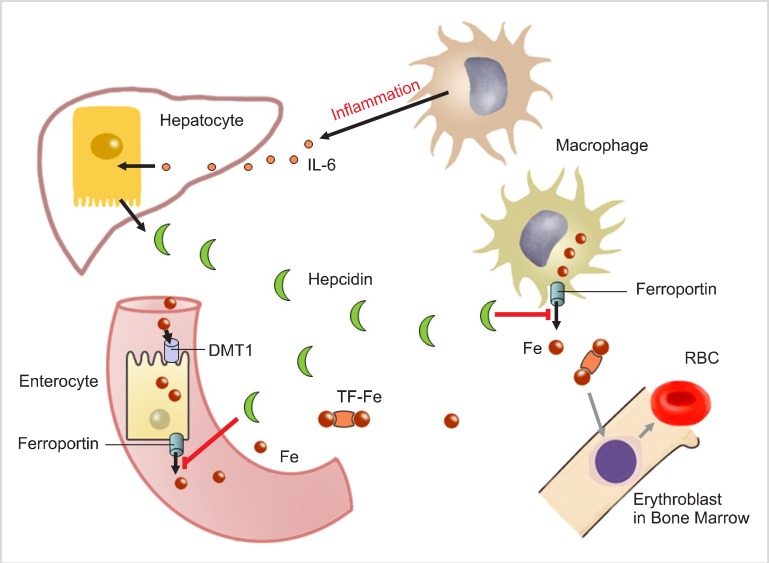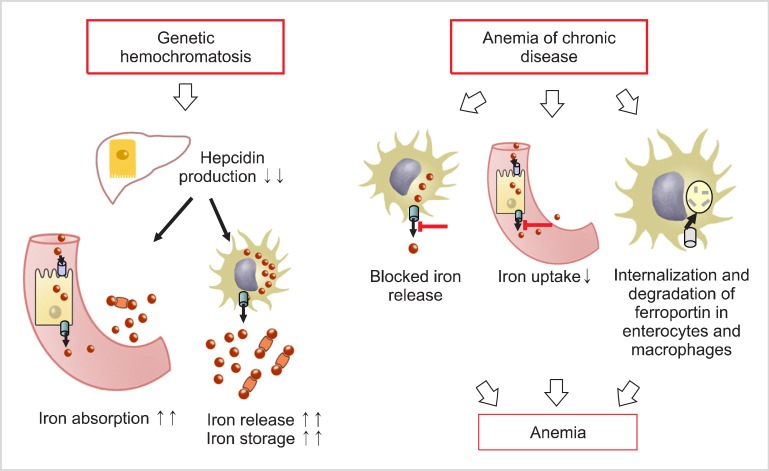Blood Res.
2013 Mar;48(1):10-15. 10.5045/br.2013.48.1.10.
Role of hepcidin in the pathophysiology and diagnosis of anemia
- Affiliations
-
- 1Ematologia/Coagulazione, Laboratorio di Chimica-Clinica, Ematologia e Microbiologia, Azienda Ospedaliera S.Antonio Abate di Callarate, Varese, Italy. guido.dangelo@aogalalrate.it
- KMID: 2270720
- DOI: http://doi.org/10.5045/br.2013.48.1.10
Abstract
- This review summarizes the central role of hepcidin in the iron homeostasis mechanism, the molecular mechanism that can alter hepcidin expression, the relationship between hepcidin and erythropoiesis, and the pathogenetic role of hepcidin in different types of anemia. In addition, the usefulness of hepcidin dosage is highlighted, including the problems associated with analytical methods currently used as well as the measures of its molecular isoforms. Considering the central role of hepcidin in iron arrangement, it is reasonable to ponder its therapeutic use mainly in cases of iron overload. Further clinical trials are required before implementation.
MeSH Terms
Figure
Reference
-
1. Weinstein DA, Roy CN, Fleming MD, Loda MF, Wolfsdorf JI, Andrews NC. Inappropriate expression of hepcidin is associated with iron refractory anemia: implications for the anemia of chronic disease. Blood. 2002; 100:3776–3781. PMID: 12393428.
Article2. Nicolas G, Chauvet C, Viatte L, et al. The gene encoding the iron regulatory peptide hepcidin is regulated by anemia, hypoxia, and inflammation. J Clin Invest. 2002; 110:1037–1044. PMID: 12370282.
Article3. Nemeth E, Valore EV, Territo M, Schiller G, Lichtenstein A, Ganz T. Hepcidin, a putative mediator of anemia of inflammation, is a type II acute-phase protein. Blood. 2003; 101:2461–2463. PMID: 12433676.
Article4. Bergamaschi G, Villani L. Serum hepcidin: a novel diagnostic tool in disorders of iron metabolism. Haematologica. 2009; 94:1631–1633. PMID: 19996112.
Article5. Ganz T, Olbina G, Girelli D, Nemeth E, Westerman M. Immunoassay for human serum hepcidin. Blood. 2008; 112:4292–4297. PMID: 18689548.
Article6. Pak M, Lopez MA, Gabayan V, Ganz T, Rivera S. Suppression of hepcidin during anemia requires erythropoietic activity. Blood. 2006; 108:3730–3735. PMID: 16882706.
Article7. Ganz T. Molecular pathogenesis of anemia of chronic disease. Pediatr Blood Cancer. 2006; 46:554–557. PMID: 16261603.
Article8. Babitt JL, Huang FW, Wrighting DM, et al. Bone morphogenetic protein signaling by hemojuvelin regulates hepcidin expression. Nat Genet. 2006; 38:531–539. PMID: 16604073.
Article9. Andriopoulos B Jr, Corradini E, Xia Y, et al. BMP6 is a key endogenous regulator of hepcidin expression and iron metabolism. Nat Genet. 2009; 41:482–487. PMID: 19252486.
Article10. Meynard D, Kautz L, Darnaud V, Canonne-Hergaux F, Coppin H, Roth MP. Lack of the bone morphogenetic protein BMP6 induces massive iron overload. Nat Genet. 2009; 41:478–481. PMID: 19252488.
Article11. Xia Y, Babitt JL, Sidis Y, Chung RT, Lin HY. Hemojuvelin regulates hepcidin expression via a selective subset of BMP ligands and receptors independently of neogenin. Blood. 2008; 111:5195–5204. PMID: 18326817.
Article12. Babitt JL, Lin HY. Molecular mechanisms of hepcidin regulation: implications for the anemia of CKD. Am J Kidney Dis. 2010; 55:726–741. PMID: 20189278.
Article13. Ashby DR, Gale DP, Busbridge M, et al. Erythropoietin administration in humans causes a marked and prolonged reduction in circulating hepcidin. Haematologica. 2010; 95:505–508. PMID: 19833632.
Article14. Tanno T, Bhanu NV, Oneal PA, et al. High levels of GDF15 in thalassemia suppress expression of the iron regulatory protein hepcidin. Nat Med. 2007; 13:1096–1101. PMID: 17721544.
Article15. Tanno T, Porayette P, Sripichai O, et al. Identification of TWSG1 as a second novel erythroid regulator of hepcidin expression in murine and human cells. Blood. 2009; 114:181–186. PMID: 19414861.
Article16. Piperno A, Galimberti S, Mariani R, et al. Modulation of hepcidin production during hypoxia-induced erythropoiesis in humans in vivo: data from the HIGHCARE project. Blood. 2011; 117:2953–2959. PMID: 21149632.
Article17. Peyssonnaux C, Zinkernagel AS, Schuepbach RA, et al. Regulation of iron homeostasis by the hypoxia-inducible transcription factors (HIFs). J Clin Invest. 2007; 117:1926–1932. PMID: 17557118.
Article18. Semrin G, Fishman DS, Bousvaros A, et al. Impaired intestinal iron absorption in Crohn's disease correlates with disease activity and markers of inflammation. Inflamm Bowel Dis. 2006; 12:1101–1106. PMID: 17119383.
Article19. Sharma S, Nemeth E, Chen YH, et al. Involvement of hepcidin in the anemia of multiple myeloma. Clin Cancer Res. 2008; 14:3262–3267. PMID: 18519751.
Article20. Peyssonnaux C, Zinkernagel AS, Datta V, Lauth X, Johnson RS, Nizet V. TLR4 dependent hepcidin expression by myeloid cells in response to bacterial pathogens. Blood. 2006; 107:3727–3732. PMID: 16391018.21. Ramsay AJ, Hooper JD, Folgueras AR, Velasco G, Lopez-Otin C. Matriptase-2 (TMPRSS6): a proteolytic regulator of iron homeostasis. Haematologica. 2009; 94:840–849. PMID: 19377077.
Article22. Melis MA, Cau M, Congiu R, et al. A mutation in the TMPRSS6 gene, encoding a transmembrane serine protease that suppresses hepcidin production, in familial iron deficiency anemia refractory to oral iron. Haematologica. 2008; 93:1473–1479. PMID: 18603562.
Article23. Finberg KE, Heeney MM, Campagna DR, et al. Mutations in TMPRSS6 cause iron-refractory iron deficiency anemia (IRIDA). Nat Genet. 2008; 40:569–571. PMID: 18408718.
Article24. Kearney SL, Nemeth E, Neufeld EJ, et al. Urinary hepcidin in congenital chronic anemias. Pediatr Blood Cancer. 2007; 48:57–63. PMID: 16220548.
Article25. Nemeth E, Ganz T. Hepcidin and iron-loading anemias. Haematologica. 2006; 91:727–732. PMID: 16769573.26. Origa R, Galanello R, Ganz T, et al. Liver iron concentrations and urinary hepcidin in beta-thalassemia. Haematologica. 2007; 92:583–588. PMID: 17488680.27. Cartwright GE. The anemia of chronic disorders. Semin Hematol. 1966; 3:351–375. PMID: 5341723.28. Tussing-Humphreys LM, Liang H, Nemeth E, Freels S, Braunschweig CA. Excess adiposity, inflammation, and iron-deficiency in female adolescents. J Am Diet Assoc. 2009; 109:297–302. PMID: 19167957.
Article29. Zaritsky J, Young B, Wang HJ, et al. Hepcidin-a potential novel biomarker for iron status in chronic kidney disease. Clin J Am Soc Nephrol. 2009; 4:1051–1056. PMID: 19406957.
Article30. De Domenico I, Ward DM, Kaplan J. Hepcidin regulation: ironing out the details. J Clin Invest. 2007; 117:1755–1758. PMID: 17607352.
Article31. Nemeth E. Targeting the hepcidin-ferroportin axis in the diagnosis and treatment of anemias. Adv Hematol. 2010; 2010:750643. PMID: 20066043.
Article32. Busbridge M, Griffiths C, Ashby D, et al. Development of a novel immunoassay for the iron regulatory peptide hepcidin. Br J Biomed Sci. 2009; 66:150–157. PMID: 19839227.
Article33. Kemna EH, Tjalsma H, Podust VN, Swinkels DW. Mass spectrometry-based hepcidin measurements in serum and urine: analytical aspects and clinical implications. Clin Chem. 2007; 53:620–628. PMID: 17272487.
Article34. Bansal SS, Halket JM, Fusova J, et al. Quantification of hepcidin using matrix-assisted laser desorption/ionization time-of-flight mass spectrometry. Rapid Commun Mass Spectrom. 2009; 23:1531–1542. PMID: 19399775.
Article35. Kroot JJ, Kemna EH, Bansal SS, et al. Results of the first international round robin for the quantification of urinary and plasma hepcidin assays: need for standardization. Haematologica. 2009; 94:1748–1752. PMID: 19996119.
Article36. Kroot JJ, Hendriks JC, Laarakkers CM, et al. (Pre)analytical imprecision, between-subject variability, and daily variations in serum and urine hepcidin: implications for clinical studies. Anal Biochem. 2009; 389:124–129. PMID: 19341701.
Article37. Weiss G. Iron, infection and anemia-a classical triad. Wien Klin Wochenschr. 2002; 114:357–367. PMID: 12708088.38. Weiss G. Pathogenesis and treatment of anaemia of chronic disease. Blood Rev. 2002; 16:87–96. PMID: 12127952.
Article39. Babitt JL, Huang FW, Xia Y, Sidis Y, Andrews NC, Lin HY. Modulation of bone morphogenetic protein signaling in vivo regulates systemic iron balance. J Clin Invest. 2007; 117:1933–1939. PMID: 17607365.
Article40. Nishimoto N, Kanakura Y, Aozasa K, et al. Humanized anti-interleukin-6 receptor antibody treatment of multicentric Castleman disease. Blood. 2005; 106:2627–2632. PMID: 15998837.
Article41. Kawabata H, Tomosugi N, Kanda J, Tanaka Y, Yoshizaki K, Uchiyama T. Anti-interleukin 6 receptor antibody tocilizumab reduces the level of serum hepcidin in patients with multicentric Castleman's disease. Haematologica. 2007; 92:857–858. PMID: 17550864.
Article42. Klaus S, Arend M, Fourney P, et al. Induction of erythropoiesis and iron utilization by the HIF prolyl hydroxylase inhibitor FG-4592. J Am Soc Nephrol. 2005; 16(Suppl):49A. (abst 050).
- Full Text Links
- Actions
-
Cited
- CITED
-
- Close
- Share
- Similar articles
-
- Understanding and exploiting hepcidin as an indicator of anemia due to chronic kidney disease
- Serum Pro-hepcidin as an Predictor of Iron Deficiency in Anemic Patients
- Relationship between Serum pro-hepcidin Concentration and Body Iron Status in Female College Students
- Hepcidin and iron parameters in children with anemia of chronic disease and iron deficiency anemia
- Iron Deficiency Anemia



